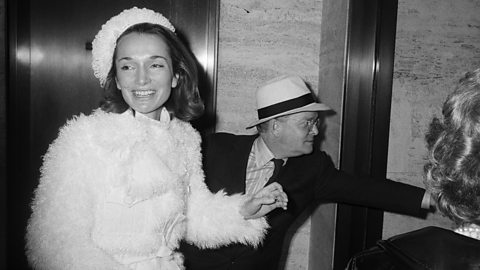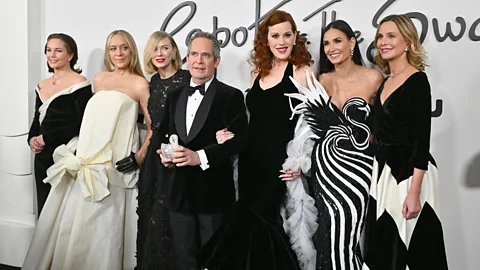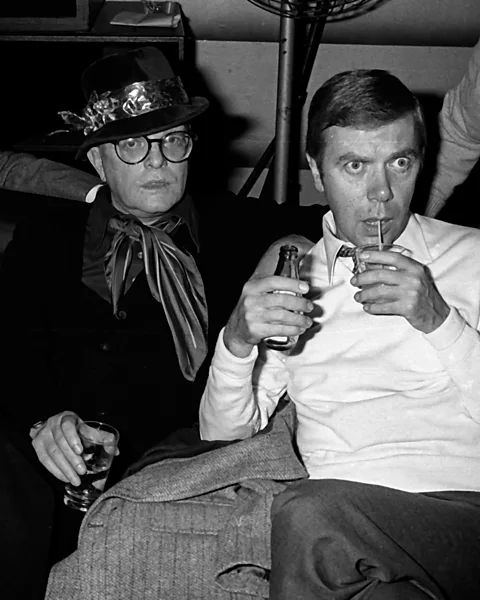By Caryn JamesFeatures correspondent

 Getty Images
Getty Images
A star-studded new miniseries from Ryan Murphy looks at how the author betrayed the confidence of some of America’s most elite women – and destroyed his career in the process.
A caricature on the cover of New York Magazine in 1975 depicted author Truman Capote as a yappy little French poodle, nipping at the fingers of a stunned woman at a black-tie party. The headline read: Capote Bites the Hands That Fed Him. The article, by the gossip columnist Liz Smith, pulled back the curtain on the real identities of the society women Capote had recently betrayed in print. Babe Paley and Slim Keith – who at the time filled the society pages and best-dressed lists – confided in him about their affairs, their philandering husbands and their insecurities, only to have their close friend mock them and reveal their most intimate secrets. His barely-veiled fiction – a story called La Côte Basque, 1965 – appeared in the widely-read Esquire magazine. The betrayal helped ruin his life.
More like this:
– The female drug barons of Latin America
That true story of a long-lost social era and of friendship gone wildly wrong is deliciously told in Feud: Capote vs the Swans, the colourful, star-filled second instalment of Ryan Murphy’s franchise that began with Bette and Joan, about the Hollywood rivalry of Bette Davis and Joan Crawford. Capote, played by Tom Hollander, is well known, if not for his books (notably Breakfast at Tiffany’s and In Cold Blood), then for the 2005 film Capote with Philip Seymour Hoffman. But who were these women he called his swans, and why did he turn on them so viciously?

 Getty Images
Getty Images
“They were like the original Real Housewives,” Murphy told Town and Country magazine, but that seems like hype. None of Capote’s refined swans ever screamed and tossed a table at La Côte Basque, the restaurant where they regularly lunched together, the way the women in that reality show have. But they did have a similar hold on the public imagination. They were elegant influencers. None of them married poor men, or dreamed of having a real career. They drank, they smoked, they wore extravagant but tasteful jewellery. And although their style can seem stodgy now – Paley’s helmet hair never moves – they were the fashion leaders of their day. Paley was regularly named on best-dressed lists.
Feud plays with the chronology and facts a bit, but mostly holds up against the truth. In 1975, Capote was at the different stage of his life from the one depicted in the film Capote. Those two fictional versions complement each other well. Hoffman’s is the serious writer, researching In Cold Blood, the 1965 true-crime book that made him rich and famous. Feud finds Capote at the height of that fame. Hollander captures the campiness and wit, and also the tragedy of a brilliant, troubled man. He had achieved his lifelong dream of being accepted by high society, but was also self-indulgent and alcoholic. He was in and out of a relationship with John O’Shea (Russell Tovey), a married, middle-class banker who the swans barely tolerated. And he was seriously blocked as a writer.
La Côte Basque, along with two less explosive stories published in Esquire, were meant to be part of Answered Prayers, a novel that he told friends and editors was his counterpart to Proust’s In Search of Lost Time, the definitive account of the upper class of his day. No one ever accused him of having a tiny ego. But he seemed unable to finish it.
Who the ‘swans’ were
Capote’s favourite swan and best friend, a perfect Proustian specimen, was Paley (Naomi Watts), serenely perfect in her demeanour and taste. Her husband, Bill Paley (played by the late Treat Williams), was the powerful head of the CBS television network, and as she well knew, a womaniser. Watts captures the brittleness of someone who needs to be perfect, and the loneliness that made her need a sympathetic shoulder like Truman’s.
In the first episode of Feud, Truman convinces her not to divorce Bill after he has slept with Happy Rockefeller, the New York governor’s wife. Paley has found him scrubbing Happy’s menstrual blood from their bedroom carpet and has had enough. With razor-like clarity, Truman advises her to stay married, keep her pampered life, and make Bill buy her a Gauguin and a Matisse instead. But that episode also sets up the real-life conflict, with Paley’s devastated reaction to La Côte Basque.

 Getty Images
Getty Images
In Capote’s story, a wealthy businessman named Dillon – soon shortened to Dill, so close to Bill – sleeps with the governor’s frumpy wife and later tries to scrub away a bloodstain “the size of Brazil”. Bill was Capote’s target, but Babe felt humiliated that her husband’s cheating was publicised to the world. Ebs Burnough, the director of The Capote Tapes, a 2022 documentary about the writer using previously unheard audio interviews with those close to him, told British Vogue, “This was an era when no one even talked about the fact that Franklin Roosevelt was in a wheelchair, let alone the affairs people were having, let alone as graphically as Truman did.” Paley never spoke to Capote again.
Although Paley was the most injured by the story, the main character in La Côte Basque is the fictional version of Slim Keith. Of all the actresses playing swans, Diane Lane may be the most fun to watch, giving her character a bold directness. Keith’s first husband was the movie director Howard Hawks, who, legend has it, used her as the model for Lauren Bacall’s tough, seductive character in To Have and Have Not, also called Slim. Her second was the producer Leland Hayward, and her third was the British businessman Kenneth Keith, whose knighthood made her Lady Keith.
Clarke, Capote’s friend and biographer, allegedly warned him that his society friends would react badly to the story. Capote’s reply was “Nah, they’re too dumb. They won’t know who they are”
La Côte Basque turns her into Lady Ina Coolbirth, “a big breezy peppy broad” who lunches with the Capote stand-in, PB Jones, a writer and sometime hustler. It is Ina who spills her friends’ secrets, name-dropping Ernest Hemingway (in fact, a friend of Slim’s) and recalling the time Joseph P Kennedy, JFK’s father, raped her (Kennedy Sr was dead by then so he couldn’t sue Capote for libel).
In Feud, Keith insists that the swans freeze Truman out of society for his betrayal, a fate that to him was almost worse than death. “We will destroy him,” she says. Years later, the real Slim Keith told Capote’s biographer, Gerald Clarke, of her horrified reaction to Lady Ina. “She looks like me, she talks like me, she’s me!” she said. About Capote, she said, “I had adored him, and I was so appalled by the use of friendship and my own bad judgment”.
CZ Guest (Chloe Sevigny, cooly understated in a major role) was also a close member of their set, a socialite and notable gardener, who appeared on the cover of Time Magazine in 1962 under the line, “What It’s Like in Society Today”. Perhaps because she did not appear in La Côte Basque, she continued to see Capote in the aftermath. She and her husband even took him to rehab when he was at his worst, drunkenly slurring his words on television talk shows. His recovery didn’t last long.

 Getty Images
Getty Images
Lee Radziwill (Calista Flockhart) is in La Côte Basque, undisguised and lunching wih her sister, Jacqueline Kennedy. In the show she joins the other swans in casting Capote out, although in life they remained friends for years after. It probably helped that, in his fiction, Ina and PB agree that Lee is so much more beautiful and elegant than Jackie.
Jon Robin Baitz, who wrote the show, told EW: “This story exists at this point where a world of elegance, ritual and class is being supplanted by a fervour of youth: disco, Studio 54, drugs.” When the middle-aged Capote, dismissed by his swans, embraced that drug-fuelled disco world, it seemed more desperately sad than thrilling.
The greatest mystery
Why he published La Côte Basque in the first place is the subject of many theories. Clarke, Capote’s friend as well as his biographer, wrote that he warned him that his society friends would react badly. Capote’s reply, he said, was “Nah, they’re too dumb. They won’t know who they are.” Liz Smith wrote in that 1975 article that the swans regarded him as “their favorite house pet”, there for their amusement. Was La Côte Basque his revenge? Capote had a standard response to the debacle, heard in his own voice in The Capote Tapes: “What did they expect? I’m a writer. I use everything.”
That may have been bravado. Joseph M Fox, in an editor’s note to the book published posthumously in 1986 as Answered Prayers – which simply collects the three Esquire stories – said of the backlash, “There’s no doubt he was shaken by the reaction.” Fox believed that was one reason he stopped working on the novel. Capote kept telling friends he had written much of it and even read excerpts, or at least pretend excerpts, aloud. But after he died in 1984, no trace of a manuscript ever surfaced. Babe Paley died of cancer in 1978. One of Capote’s great regrets was that she never forgave him.
The swans are having their moment now, and not just because of the show. Women’s Wear Daily recently called them “fashion icons whose influence still resonates today”, noting that Radziwill and Paley inspired Lanvin’s 2020 spring/summer collection. The Washington Post featured the show in an article titled, “Ladies Who Lunch Have Become 2024’s Unexpected Fashion Icons”.
But it is the real-life drama that continues to be spellbinding. In his preface to Music for Chameleons, his 1980 collection of short pieces, Capote addressed the start-and-stop process of writing Answered Prayers, and explained – perhaps with a dash of fabulism – why he had no trouble remembering the details. “All the characters were real,” he wrote. “I hadn’t invented anything.”
Feud: Capote vs The Swans premieres on 31 January on FX in the US and will be available to stream on Hulu from 1 February.
If you liked this story, sign up for The Essential List newsletter – a handpicked selection of features, videos and can’t-miss news delivered to your inbox every Friday.
If you would like to comment on this story or anything else you have seen on BBC Culture, head over to our Facebook page or message us on Twitter.





